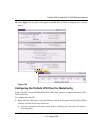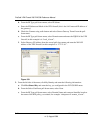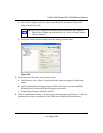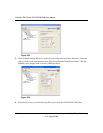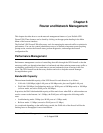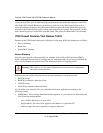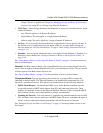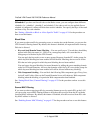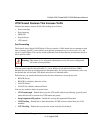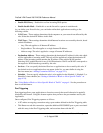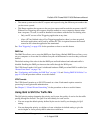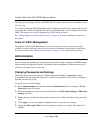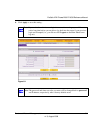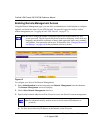
ProSafe VPN Firewall 200 FVX538 Reference Manual
Router and Network Management 6-3
v1.0, August 2006
– Groups: The rule is applied to a Group (see “Managing Groups and Hosts (LAN Groups)”
on page 3-6to assign PCs to a Group using Network Database).
• WAN Users – These settings determine which Internet locations are covered by the rule, based
on their IP address.
– Any: The rule applies to all Internet IP address.
– Single address: The rule applies to a single Internet IP address.
– Address range: The rule is applied to a range of Internet IP addresses.
• Services – You can specify the desired Services or applications to be covered by this rule. If
the desired service or application does not appear in the list, you must define it using the
Services menu (see “Services-Based Rules” on page 4-2 and “Adding Customized Services”
on page 4-21).
• Schedule – You can specify whether the rule is to be applied on the Schedule 1, Schedule 2, or
Schedule 3 time schedule (see “Setting a Schedule to Block or Allow Specific Traffic” on
page 4-24).
See “Using Rules to Block or Allow Specific Kinds of Traffic” on page 4-1 for the procedure on
how to use this feature.
Services. The Rules menu contains a list of predefined Services for creating firewall rules. If a
service does not appear in the predefined Services list, you can define the service. The new service
will then appear in the Rules menu's Services list.
See “Services-Based Rules” on page 4-2 for the procedure on how to use this feature.
Groups and Hosts. You can apply these rules selectively to groups of PCs to reduce the
outbound or inbound traffic. The Network Database is an automatically-maintained list of all
known PCs and network devices. PCs and devices become known by the following methods:
• DHCP Client Request – By default, the DHCP server in this Router is enabled, and will
accept and respond to DHCP client requests from PCs and other network devices. These
requests also generate an entry in the Network Database. Because of this, leaving the DHCP
Server feature (on the LAN screen) enabled is strongly recommended.
• Scanning the Network – The local network is scanned using standard methods such as ARP.
This will detect active devices which are not DHCP clients. However, sometimes the name of
the PC or device cannot be accurately determined, and will be shown as Unknown.
See “Managing Groups and Hosts (LAN Groups)” on page 3-6 for the procedure on how to use
this feature.



